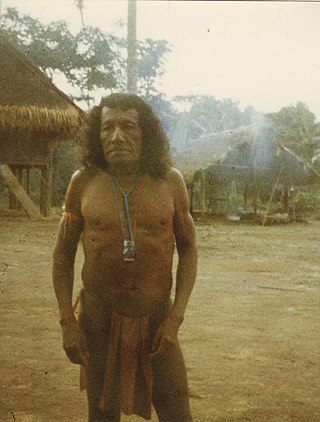
The Tiriyó are an Amerindian ethnic group native to parts of northern Brazil, Suriname, and Guyana. In 2014, there were approximately 3,640 Tiriyó in the three countries. They live in several major villages and a number of minor villages in the border zone between Brazil and Suriname. They speak the Tiriyó language, a member of the Cariban language family and refer to themselves as tarëno, etymologically 'people from here' or 'local people'.

The Aluku are a Bushinengue ethnic group living mainly on the riverbank in Maripasoula in southwest French Guiana. The group are sometimes called Boni, referring to the 18th-century leader, Bokilifu Boni.
Kawemhakan, formerly also known as Anapaikë, is a Wayana village in the Sipaliwini District of Suriname. The village lies on the banks of the Lawa River, which forms the border with French Guiana.
The Aparai or Apalai are an indigenous people of Brazil, who live in Amapá and Pará states. A little community is located in French Guiana, in Antecume Pata. They were sedentary slash-and-burn farmers, necessitating periodic relocation as soil became exhausted, but also hunters and gatherers. They spoke a Carib language and in the 20th century their subsistence shifted towards craftwork as they adapted to modern Brazil and the cash economy.

The Wayana are a Carib-speaking people located in the southeastern part of the Guiana highlands, a region divided between Brazil, Suriname, and French Guiana. In 1980, when the last census took place, the Wayana numbered some 1,500 individuals, of which 150 in Brazil, among the Apalai, 400 in Suriname, and 1,000 in French Guiana, along the Maroni River. About half of them still speak their original language.

Granman is the title of the paramount chief of a Maroon nation in Suriname and French Guiana. The Ndyuka, Saramaka, Matawai, Aluku, Paramaka and Kwinti nations all have a granman. The paramount chiefs of Amerindian peoples in Suriname are nowadays also often called “granman”.

Antecume Pata is a village in French Guiana, France. It was founded by André Cognat, a Pierre-Bénite-born Wayana tribal chief. It is home to a nursery and primary state school. Even though French is taught at the school, Sranan Tongo is still the lingua franca in the region.
Kulumuli, also known by the name Twenkë, is a Wayana village situated on an island in the Lawa River in French Guiana. Kulumuli is the residence of the granman of the Wayana in French Guiana.

Élahé, also known by the names Malipahpan and Maripahpan, is a Wayana village on the Tampok River in French Guiana. A minority of Teko also live in the village.
Kayodé or Cayodé is a Teko and Wayana village on the Tampok River in French Guiana.
Talhuwen, also spelt as Taluwen, Taluhen and Taluen, is a Wayana village situated on the Lawa River in French Guiana.
Epoja, also known as Opoya, is a Wayana village situated on the Lawa River in French Guiana.
Pëleya, also spelt as Péléa, is a Wayana village on an island in the Litani River.
Palimino is a Wayana village on the Litani River.
Kumakahpan is a Wayana village in the Sipaliwini District of Suriname. The village lies on the banks of the Lawa River, which forms the border with French Guiana.
Alawataimë enï is a Wayana village situated on the Lawa River in French Guiana.
Palasisi, also named Mapahpan or Palassisi, is a Wayana village on an island in the Litani River. The village was founded by Wayanas who emigrated from Brazil.
Pïleike was a Wayana village in the Sipaliwini District of Suriname. The village lies across the Lawa River from the island village of Kulumuli, which is considered to lie in French Guiana. As of 2009, the village is abandoned.
Tedamali, also known as Telamali, is a Wayana village on the Lawa River in French Guiana.

The Malani, also Marouini, is a river in the disputed area between French Guiana and Suriname. According to Suriname, it is the border river, however France considers the Litani the border. The river has its source at Pic Coudreau in the Tumuk Humak Mountains. It has its mouth at the confluence with the Litany at Antecume Pata and continues its journey as the Lawa River. The Malani has a length of 245 kilometres (152 mi).








